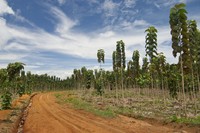Shedding Problem in Teak Farms
/ A monoculture Teak tree farm in PanamaThe ITTO’s latest marketplace review included a report from India revealing the negative impacts monoculture Teak plantations are causing.
A monoculture Teak tree farm in PanamaThe ITTO’s latest marketplace review included a report from India revealing the negative impacts monoculture Teak plantations are causing.
The problem seems to be caused by the Teak tree’s tendency to shed its leaves during the dry season, reducing the amount of shading of the understory. Increased sunlight dries up pools of water on the ground, which are important for the survival of flora and fauna. In a more biodiverse plantation forest (or first growth forest) the trees maintain a constant canopy that provides the shade to maintain these pools of water.
During the dry season in Panama, you can see the ground cracking in the Teak plantations, but in the more biodiverse forests, there is no cracking.
While we do plant some Teak in as part of our species mix, the majority of our plantations are mixed tree species native to Panama. We purposefully leave buffers around water sources and non-commercial trees standing in order to provide biodiversity benefits, reduce erosion, and reduce the risk of blight and pests.
The majority of investment goes into monoculture Teak plantations. We hope, however, that this study draws attention to the negative environmental impacts caused by single-species plantations and encourages the creation of more sustainable forest investments.
What should you be looking for in a forest investment?



